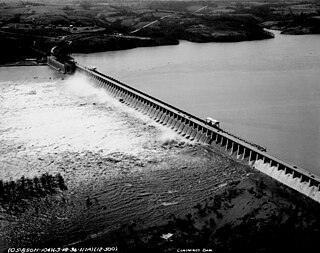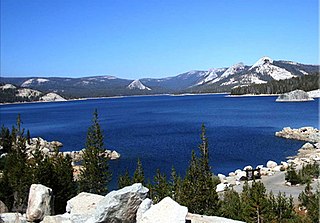
The Ludington Pumped Storage Plant is a hydroelectric plant and reservoir in Ludington, Michigan. It was built between 1969 and 1973 at a cost of $315 million and is owned jointly by Consumers Energy and DTE Energy and operated by Consumers Energy. At the time of its construction, it was the largest pumped storage hydroelectric facility in the world.

The Bath County Pumped Storage Station is a pumped storage hydroelectric power plant, which is described as the "largest battery in the world", with a maximum generation capacity of 3,003 MW, an average of 2,772 MW, and a total storage capacity of 24,000 MWh. The station is located in the northern corner of Bath County, Virginia, on the southeast side of the Eastern Continental Divide, which forms this section of the border between Virginia and West Virginia. The station consists of two reservoirs separated by about 1,260 feet (380 m) in elevation. It was the largest pumped-storage power station in the world until 2021, when it was surpassed by the Fengning Pumped Storage Power Station.

The Conowingo Dam is a large hydroelectric dam in the lower Susquehanna River near the town of Conowingo, Maryland. The medium-height, masonry gravity dam is one of the largest non-federal hydroelectric dams in the U.S., and the largest dam in the state of Maryland.

Raccoon Mountain Pumped-Storage Plant is a pumped-storage hydroelectric underground power station in Marion County, just west of Chattanooga in the U.S. state of Tennessee.

Courtright Reservoir is a reservoir in Fresno County, California. The reservoir is at an elevation of 8,170 feet in the Sierra National Forest, in the Sierra Nevada Mountain Range, bordering the John Muir Wilderness and the Dinkey Lakes Wilderness.

Conowingo is a community in northwestern Cecil County, Maryland, United States. The community replaced a previous one that was inundated by a reservoir.
Eugene C. Whitney was a celebrated power engineer who designed hydroelectric turbines and generators at Westinghouse Electric Company. The pinnacle of his career was the machinery for the expansion of the Grand Coulee Dam to add the #3 Powerhouse in 1966–74.

Susquehannock State Park is a Pennsylvania state park on 224 acres (91 ha) in Drumore Township, Lancaster County, Pennsylvania in the United States. The park is on a scenic plateau overlooking the Susquehanna River and Conowingo Reservoir. The park is named for the Susquehannock people, who lived in the area. Susquehannock State Park is located on small roads a few miles south of Pennsylvania Route 372 and west of Pennsylvania Route 272. The nearest city is Quarryville, Pennsylvania, about 12 miles (19 km) East.

Cougar Dam is a 519-foot (158 m) tall rockfill hydroelectric dam in the U.S. state of Oregon. It has a gated concrete spillway and a powerhouse with two turbines totaling 25 megawatts of electric power.

The Kannagawa Hydropower Plant (神流川発電所) is an under construction pumped-storage hydroelectric power plant near Minamiaiki in Nagano Prefecture and Ueno in Gunma Prefecture, Japan. The power plant utilizes the Minamiaiki River along with an upper and lower reservoir created by two dams, the upper Minamiaiki Dam and the lower Ueno Dam. The power station in between the two dams will contain six 470 megawatts (630,000 hp) pump-generators for a total installed capacity of 2,820 megawatts (3,780,000 hp). Unit 1 commenced commercial operation in 2005 and Unit 2 in 2012. When completed, the plant will have the third-largest pumped-storage power capacity in the world.
The Yangyang Pumped Storage Power Station uses the water of the Namdae-Chun River to operate a 1,000-megawatt (1,300,000 hp) pumped storage hydroelectric power scheme, about 10 kilometres (6.2 mi) west of Yangyang in Gangwon Province, South Korea. The lower reservoir is created by the Yangyang Dam on the Namdae and the upper reservoir by the Inje Dam is located 937 metres (3,074 ft) above the power plant. Construction on the power plant began in 1996 and it was completed and dedicated on September 13, 2006. It is operated by Korean Midland Power Co., a subsidiary of Korea Electric Power Company and was completed at a cost of ₩1.1 trillion won. The first generator was operational on February 23, 2006 and the last August 10, 2006.

Castaic Power Plant, also known as the Castaic Pumped-Storage Plant, is a seven unit pumped-storage hydroelectric plant, operated by the Los Angeles Department of Water and Power, which provides peak load power from the falling water on the West Branch of the California State Aqueduct. It is a cooperative venture between the LADWP and the Department of Water Resources of the State of California. An agreement between the two organizations was signed on September 2, 1966, for construction of the project.
The Salina Pumped Storage Project is a 260-megawatt (350,000 hp) pumped-storage power station near Salina, Oklahoma. It is owned and operated by the Grand River Dam Authority (GRDA). Its construction was in response to growing power demands and a lack of dam sites on the Grand River. The first phase was completed in 1968 and the second in 1971. The upper reservoir for the power station is Lake W. R. Holway which was built on Saline Creek and the lower reservoir is Lake Hudson on the Grand River. During periods of lower power demand, water is pumped from Lake Hudson to Lake Holway and released back down through the pump-generators during periods of high energy demand.

The Helms Pumped Storage Plant is located 50 mi (80 km) east of Fresno, California in the Sierra Nevada Mountain Range's Sierra National Forest. It is a power station that uses Helms Creek canyon on the North Fork of the Kings River for off-river water storage and the pumped-storage hydroelectric method to generate electricity. After being planned in the early 1970s, construction on the plant began in June 1977 and commercial operations began on 30 June 1984. It has an installed capacity of 1,212 MW and is owned by Pacific Gas and Electric Company.

The Rocky Mountain Hydroelectric Plant is a pumped-storage power plant located 10 miles (16 km) northwest of Rome in the U.S. state of Georgia. It is named after Rock Mountain on top of which the plant's upper reservoir is located. Construction on the plant began in 1977 and it was commissioned in 1995. After upgrades were completed in 2011, the plant has an installed capacity of 1,095 megawatts (1,468,000 hp). It is owned by both Oglethorpe Power and Georgia Power which have 75 percent and 25 percent stakes, respectively.

Bear River Dam is a dam in Amador County, California, due east of Sacramento.
The Cushaw Hydroelectric Project is a 7.5 megawatt (MW) dam and power house facility owned and operated by Cushaw Hydro LLC.

The Omarugawa Pumped Storage Power Station is a large pumped-storage hydroelectric power station in Kijo in the Koyu District of Miyazaki Prefecture, Japan. With a total installed capacity of 1,200 megawatts (1,600,000 hp), it is one of the largest pumped-storage power stations in Japan.

The Shimogo Pumped Storage Power Station is a large pumped-storage hydroelectric power plant in Shimogō, Minamiaizu, Fukushima Prefecture, Japan. With an installed capacity of 1,000 megawatts (1,300,000 hp), the system is one of the largest pumped-storage power stations in Japan.














